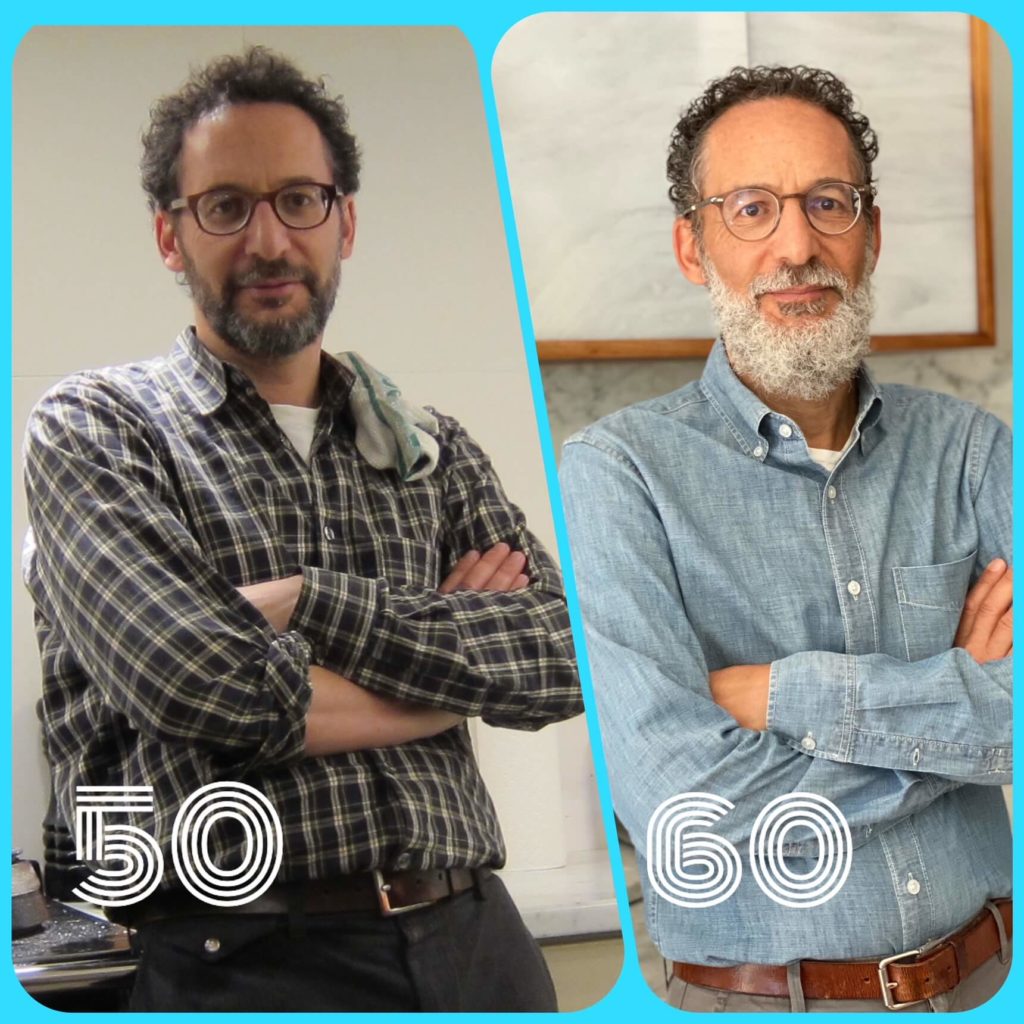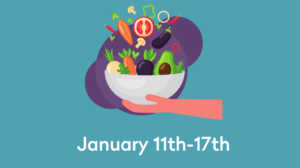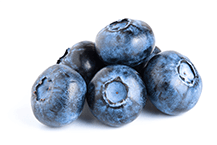By Michael
While most people measure their age chronologically, I’ve always been a believer in the importance of biological age, or measuring how my body is aging and how it is impacted by diet, exercise, stress, sleep, genes and the environment. Accordingly, when I turned 60 last month, I began to consider how my health has changed over the past decade. On the surface, as you can see in the image, not much is different other than the color of my beard which has gone quite grey. But upon reflection, I’ve made several important changes in my life that have impacted my overall health in many beneficial ways that may not be visible on the surface. Many of these changes have been inspired by my research over the past 3 decades, and also by the Sugarproof project, and I’d like to share some of these changes with you and my 5 takeaways.
Physiological Health – It’s the Inside that Counts
I didn’t pay very much, if any, attention to my weight in my childhood and adolescence. My body seemed to maintain a normal weight without much thought and by the time I was in college I weighed around 140 lbs. However, as I headed into my 40’s things began to change. I was on a holiday overseas when I noticed that after a week of rich meals and decadent desserts, I looked and felt a little bloated, or so I thought. In fact, my weight had creeped up to 170 pounds into the overweight range. I began to focus more on my diet and exercise, and over the course of six months, I lost 20 pounds. I started running and charted my progress towards getting back to a goal of 150 pounds with regular weigh-ins. Subsequently, I have maintained the practice of tracking my weight over time with a Withings scale, and my daily activity with a Withings watch, both connected to the HealthMate app. This helps me to see fluctuations and patterns throughout the seasons, as well as trends that span years – monitoring these longer term trends are more useful than trying to make sense of day to day fluctuations. I find this helpful because now if I see that I’ve gained a few pounds after a weeklong holiday or like at the beginning of the lockdown in 2020, I can quickly adjust to get back on track. Over the last decade, my weight has fluctuated between a low of 145 and a high of 153 averaging 148 pounds. Research studies have shown that tracking weight is one of the most effective tools for weight maintenance.
Since weight alone doesn’t always correlate with health, I have also found it helpful to monitor other health indicators. My blood pressure has remained very stable over the last ten years and my fasting blood glucose has fluctuated between the low 90’s and the high 90’s. In my mid 50’s my HbA1c (a measure of average blood glucose over 3 months) came back in the lowest range of the clinical diagnosis of pre-diabetes (5.7), even though my fasting glucose was in the healthy range. This was of concern and curious to learn more, I wore a Libre freestyle glucose monitor to track my glucose levels continuously over 2 weeks. I learned that my blood glucose had a 2-week average of 94, and was within normal range >98% of the time. Wearing the monitor also helped reinforce what I already knew: identify high glycemic meals and adjust them in ways to reduce glucose spikes such as adding fiber and protein and many of the other hacks we talk about in Sugarproof. For example, I swap jam on toast for protein-rich ricotta or scrambled eggs, and add fiber and protein to smoothies to minimize glucose spikes. Consequently, over the last 5 years I have been able to maintain my HbA1c around 5.7 and prevent a progression into the range of pre-diabetes.
On the other hand my cholesterol has been trickier to manage. In my early 40’s, my LDL cholesterol had crept up to over 200. I tried several strategies to lower it, such as cutting out eggs and saturated fat, as well as taking various supplements (fish oil, plant sterols, red yeast rice), but the effect was minimal. High cholesterol can have a hereditary component and is common in my family, so I reluctantly went on a statin (lipitor). I was able to gradually titrate the dosage downwards and found that taking the minimal dose of 10mg every other day was enough to keep my LDL-cholesterol well below 100.
Dietary Health Starts with Quality Food
Choosing what to eat has always been important to me, so I have never adhered to any type of strict diet and prefer to focus on good quality food. Perhaps I was influenced by the foods I grew up on in our Jewish household in Glasgow. While Scotland in the 60’s and 70’s might not conjure an image of a healthy diet, my mother spent hours in the kitchen cooking homemade soups, salads, breads, fish, roasts and cakes, using ingredients delivered weekly to the house from the local fishmonger, butcher and greengrocer. I had my fair share of Irn Bru (Google it!) and Cadbury’s Dairy Milk, and my favorite desserts of trifle or anything with custard, but overall I was primarily eating fresh unprocessed whole foods and a lot of great home cooking. My diet today isn’t too different – I eat fish at least weekly, eggs most days of the week, and otherwise lots of fruits and vegetables and other sources of fiber and probiotics to promote my gut health, with only minimal amounts of processed foods, added sugars, refined carbs and red meat. What to have for dinner is a lively topic of debate in our household with my wife and 2 teenage daughters, and we enjoy sharing the tasks of choosing and preparing meals. We are also careful about what types of foods we buy and we try to shop at our neighborhood farmer’s market or we sometimes order local farm boxes. In addition, I am currently focused on learning more about my gut microbiome and its role in the link between diet and health. In fact, my wife and I recently participated in the Zoe health study in order to learn more about our bodies’ responses to foods and how this is related to our gut microbiome.
As I have gotten older, I’ve noticed that I have intentionally begun to eliminate things in my diet that I no longer enjoy because of the negative effect they have on my system. Consequently, I no longer drink coffee, alcohol or other bottled beverages. My daily beverage of choice is loose leaf Japanese green sencha tea, and I drink matcha tea a few times a week. One of the more impactful lifestyle changes I have made in the past few years is intermittent fasting, also known as time restricted eating. Most days I fast between after dinner (usually around 7-8pm) and around 11am, basically combining breakfast and lunch into a late morning meal. Studies have shown that this eating style improves cellular and cognitive health. I personally find that fasting until late morning gives me more energy during the day and I don’t end up eating more than usual in the afternoons or evenings. In addition, I have found that this approach helps me to stabilize my blood sugar. We do not suggest intermittent fasting (or skipping breakfast) for kids unless prescribed by your pediatrician to address a major concern, such as excess weight, type 2 diabetes or fatty liver, but there is good research to show that it can be effective for adults.
Maintaining a Physically Active Life
With a sedentary job there are plenty of days where I’ll be lucky to get in 1,000 steps. I wear a Withings Activite watch every day that tracks my steps towards a goal of 10,000. While I try to go on daily walks and run once or twice a week, I am not on a strict routine and my average daily steps is around 6,000 per day. I prefer to be intuitive about my physical activity and I find that an open mindset/spontaneity keeps me from getting bored, and the variety effectively helps condition multiple muscle groups and can help avoid overuse injuries. The biggest change for me in the past 10 years is that I have rediscovered my childhood love for tennis and I now play twice a week, enjoying both singles and doubles play. Tennis has improved my endurance, strength and agility, as well as my mental health. Tennis for me is an incredible stress reliever, from the minute I walk on to the court. Even just the sound of tennis balls being hit back and forth is relaxing to me. In the last few years, I have noticed more frequent aches and pains, so I have started to actively work towards building more muscle tone, strength and flexibility using yoga and a weekly workout with weights and active stretching.
Takeaways and Lessons Learned
We all know that life is unpredictable and that nothing is guaranteed, but here are 5 key takeaway lessons that I have learned from my own health journey.
ONE: Monitor your health in the same way you probably monitor your bank accounts and investments. Look for patterns that may be slowly evolving over years. This monitoring is more important as you get older to catch early warning signs and make adjustments. Get your routine checks and monitor them over time in a spreadsheet or through your healthcare portal (which I didn’t have till recently). Just because you are eating well and feeling good doesn’t mean to say there may not be something brewing under the hood. Keep records and monitor because early detection and adjustment is key.
TWO: More than likely there is no specific diet or exercise plan that will work for you because everyone is different, and your body, your preferences and your needs change over time. As I have gotten older and observed diet and exercise trends come and go, it has become clear to me that everyone has to find their own path to good health. Your individual response to food depends on many factors, some obvious (age, genetics, microbiome, allergies, pre-existing conditions) and some not so obvious (time of day, amount of portion, food combinations, etc). Personalized medicine is the future and so is personalized nutrition. All people are different people. Listen and learn from your own body and find out what type of foods and physical activities work for you.
THREE: Instead of following a more prescribed plan, which may work for some people, I prefer a more flexible approach. For more flexibility, stick to some basic guidelines, such as those outlined in Michael Pollan’s book, Food Rules – “Eat Food, Not Too Much, Mostly Plants”, or Tim Spector’s mantra of aiming for 30 different plants a week. In addition, there are a few other simple guidelines that would be hard to argue with when it comes to diet: less sugar and less processed foods can’t hurt, and neither can more fiber, fresh fruits and vegetables and healthy sources of protein. Keep it flexible.
FOUR: Ultimately food is meant to be enjoyed but unfortunately deciding what’s best to eat has become quite complicated. Whatever plan you choose, make sure it is rewarding, fun and enjoyable enough to sustain over the years to come.
FIVE: I often get questions like, “aren’t eggs bad for health?”, “is oat milk good or bad – doesn’t it spike blood glucose?”, or “are smoothies really healthy because if they are blended too much the fibers will get sheared?”. These are all good questions, but they are very difficult to answer and there is often no right or wrong answer. The best way to answer is to see what works for you. I eat eggs regularly and have maintained a stable blood lipid level. I drink oat milk and have maintained a stable blood glucose. And I enjoy smoothies and like to load them with nutrients. Keep it simple and try not to get bogged down in too much detail so you don’t lose sight of the big picture which is your own overall health status.
Would my health be doing better if I didn’t eat eggs, drink smoothies or if I stuck with a more prescriptive diet or different set of dietary guidelines or exercise routine? It’s impossible to know. But so far, in the big picture, I’m doing OK, and just as importantly, maybe more importantly, I am enjoying making and eating the food that I eat while following a few simple guidelines to monitor and keep my diet and health on track.


